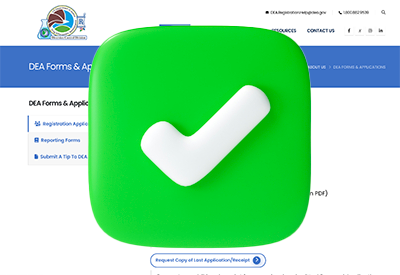Home » Suboxone: An Overview
Suboxone: An Overview
May 1, 2010
From The Carlat Psychiatry Report
Daniel Carlat, MD
Opioid drugs represent one of the great triumphs of medicine, because they are extremely effective at relieving pain. Since the 1960s, multiple forms of synthetic opioids have been introduced, including such wellknown drugs as hydrocodone (Vicodin) and oxycodone (Percocet, Oxycontin). Unfortunately, the array of opiate options has led to an exponential rise in the abuse of prescription opiates, and a corresponding explosion of deaths due to opiate overdose. (For a good review of these issues, see Lanier W and Kharasch E, Mayo Clinic Proceedings 2009:84(7):572–575.) Equally unfortunate is that getting off of opiates is extremely difficult, and the best that many addicts can hope for is opioid maintenance, which is essentially trading one narcotic addiction for another.
For decades, methadone was the mainstay of opioid maintenance. Methadone has the advantage of being a very long acting oral opiate that can substitute well for street drugs such as IV heroin. And although methadone is effective for many patients, it poses problems. In order to prevent diversion of methadone, the federal government requires patients to visit federally-licensed methadone clinics daily—in effect handcuffing patients to a methadone clinic lifestyle. Patients with full-time jobs or those who want to travel or live in rural areas have a very hard time participating in methadone maintenance programs.
In 2002, the FDA approved Suboxone (sublingual buprenorphine/naloxone) for the treatment of opioid dependence. Suboxone revolutionized opioid maintenance treatment because it is less abusable than methadone, and therefore can be prescribed by physicians from their offices. The main ingredient in Suboxone is buprenorphine, a semisynthetic opioid that has been available as an injectable narcotic (brand name Buprenex) since 1981. Buprenorphine is a partial opioid agonist, meaning that it occupies the opiate receptors but doesn’t cause quite the same intensity of receptor activation (or “high”) as full opiate agonists such as oxycodone or methadone. The other ingredient in Suboxone is naloxone, which is an opiate blocker best known for emergency treatment of opioid overdose. Suboxone is composed of buprenorphine and naloxone in a ratio of 4:1.
Why, you might ask, would you combine an opiate antagonist with an opiate agonist? This is a neat pharmacological trick to prevent Suboxone from being ground up and shot intravenously. When taken as directed (sublingually), the buprenorphine works, but naloxone is poorly absorbed through the buccal mucosa and has only a minimal effect. However, when the tablets are crushed up and injected, naloxone comes alive, preventing the high and causing immediate withdrawal symptoms in patients addicted to opiates. Methadone, on the other hand, can be injected and will deliver a potent high, making it far more prone to abuse and diversion than Suboxone.
Although Suboxone has been shown to be superior to clonidine for opioid detoxification (Ziedonis DM et al., Drug Alcohol Depend 2009;99(1–3):28–36), its greatest strength lies in its FDA-approved use as an alternative to methadone for opioid maintenance therapy. A pivotal 52-week trial demonstrated Suboxone’s superiority to placebo in maintaining opioid-negative urine tests (Fudala PJ et al., N Engl J Med 2003;349(10):949–958); two randomized trials demonstrated non -inferiority to methadone maintenance therapy at 17 weeks and six months (Kakko J et al., Am J Psychiatry 2007;164(5):797–803); and clinical studies have shown effectiveness in maintaining sobriety in “real world” primary care settings (Cunningham C et al., Fam Med 2008;40(7):500–506).
Compared with methadone, Suboxone’s most obvious advantage is that it allows office-based maintenance treatment of opioid dependence. The difference in quality of life between patients on Suboxone versus methadone maintenance can be tremendous. Suboxone is also safer than methadone, since as a partial agonist, it is less likely to cause respiratory depression in overdose—although it can still cause significant sedation and respiratory depression when combined with benzodiazepines or other CNS depressants. Since Suboxone is still under patent, it is expensive, but because fewer office visits are needed, the overall cost of treatment is comparable to that of methadone maintenance (Doran CM, Expert Rev Pharmacoeconomics Outcomes Res 2005;5(5):583–591).
Although Suboxone theoretically is less abusable than other opiates, diversion and abuse of the drug have become extremely common. Because of this, the DEA tightly regulates its use. Physicians must complete an eight-hour CME course in order to obtain a special DEA number (known as a DATA 2000 waiver) before they can prescribe Suboxone. Even with the waiver, the DEA limits the number of patients on your Suboxone “panel” to a maximum of 30 during your first year of prescribing, and a maximum of 100 patients thereafter. (See the SAMSHA website at http://bit.ly/73fMfd for more information.)
So let’s assume you’ve attained your DATA 2000 waiver and are ready to prescribe Suboxone. Here’s how it’s typically done. The first phase of treatment is called the “induction.” Before a patient receives the first dose, he must be in opiate withdrawal. Why? Because if the patient has opiates in his system, Suboxone will bump the opiates off the binding sites and will precipitate a withdrawal—not a great way to foster the doctor patient alliance! As a rough rule of thumb, Oxycontin users should have taken their last dose no less than 24 hours before Suboxone to insure adequate withdrawal, and heroin users, about 12 hours. But to accurately assess the degree of withdrawal, you should use the Clinical Opiate Withdrawal Scale (COWS), which is available for free online at http://bit.ly/d0E9Ur. The scale will walk you through an assessment of the typical signs of opiate withdrawal, such as sweating, chills, yawning, muscle aches, nausea and vomiting.
Once your patient is clearly in withdrawal, you start by giving a 2 or 4 mg dose, then have the patient wait in the waiting room for an hour, and then reassess. If the withdrawal symptoms have disappeared, you have a good starting dose. If the symptoms have improved somewhat, you should give another 2 to 4 mg. And if the symptoms have worsened…well, then you’ve pretty much blown it because this means the patient was not in enough withdrawal at the beginning of the process. After you’ve estimated an adequate dose, you should see a patient daily for two or three days, then less often once you feel comfortable that he or she has been properly induced. Eventually, visit frequency is titrated down to monthly for most patients. A typical final target dose of Suboxone is in the range of 12 to 16 mg per day.
During each visit, the first thing to ask is: “Have you used?” because relapse to opiate abuse is common, as is abuse of other substances such as amphetamines, cocaine and benzodiazepines. Assess for signs of withdrawal at each visit, asking particularly about waking night sweats (which some patients may not realize is a symptoms of withdrawal), and about craving, which is often the “last stand” of the withdrawal syndrome and puts patients at high risk of relapse. If withdrawal symptoms occur, this generally means that the dose of Suboxone should be nudged higher.
Therapy during Suboxone visits should focus on identification and avoidance of triggers for drug use, support for efforts to get a job, and general encouragement to create as much structure in the patient’s life as possible. As you might imagine, many Suboxone patients have substantial psychiatric comorbidity, especially anxiety and mood disorders. While this could make treatment very complicated, most patients see a different psychiatrist for issues outside the realm of the addiction. “Farming out” treatment of comorbidities allows you to keep focused on the addiction while ensuring that patients still receive adequate treatment for other issues.
Because of the risk of diversion, working with Suboxone patients requires firm ground rules, and the dictum “I trust you, but I don’t trust your addiction” applies. Let patients know that there are no refills on their prescriptions, and if they miss an appointment, they will have to wait for another opening before they can get a new script. Most clinics require attendance at 12 step meetings, and require enrollment in a random urine drug testing program. Some states have a searchable database of all patients who have filled prescriptions for controlled substances, and looking up each patient every two or three months is a required safeguard to help detect doctor shopping. With all the hoops to jump through, you might find the idea of prescribing Suboxone daunting, but it can be fulfilling to work with this clientele, and for some practitioners it has become a lucrative practice model.
Suboxone Resources Suboxone Talk Zone (http://suboxonetalkzone.com) is a blog written by Jeffrey T Junig MD, PhD, a physician and recovering opiate addict. He sells an e-book on his blog called User’s Guide to Suboxone, which is a helpful handbook for both patients and prescribers. A standard Agreement for Treatment with Sublingual Buprenorphine/ Naloxone (Suboxone®) is available here. You are free to download and use this document in your own practice.
General PsychiatryFor decades, methadone was the mainstay of opioid maintenance. Methadone has the advantage of being a very long acting oral opiate that can substitute well for street drugs such as IV heroin. And although methadone is effective for many patients, it poses problems. In order to prevent diversion of methadone, the federal government requires patients to visit federally-licensed methadone clinics daily—in effect handcuffing patients to a methadone clinic lifestyle. Patients with full-time jobs or those who want to travel or live in rural areas have a very hard time participating in methadone maintenance programs.
In 2002, the FDA approved Suboxone (sublingual buprenorphine/naloxone) for the treatment of opioid dependence. Suboxone revolutionized opioid maintenance treatment because it is less abusable than methadone, and therefore can be prescribed by physicians from their offices. The main ingredient in Suboxone is buprenorphine, a semisynthetic opioid that has been available as an injectable narcotic (brand name Buprenex) since 1981. Buprenorphine is a partial opioid agonist, meaning that it occupies the opiate receptors but doesn’t cause quite the same intensity of receptor activation (or “high”) as full opiate agonists such as oxycodone or methadone. The other ingredient in Suboxone is naloxone, which is an opiate blocker best known for emergency treatment of opioid overdose. Suboxone is composed of buprenorphine and naloxone in a ratio of 4:1.
Why, you might ask, would you combine an opiate antagonist with an opiate agonist? This is a neat pharmacological trick to prevent Suboxone from being ground up and shot intravenously. When taken as directed (sublingually), the buprenorphine works, but naloxone is poorly absorbed through the buccal mucosa and has only a minimal effect. However, when the tablets are crushed up and injected, naloxone comes alive, preventing the high and causing immediate withdrawal symptoms in patients addicted to opiates. Methadone, on the other hand, can be injected and will deliver a potent high, making it far more prone to abuse and diversion than Suboxone.
Although Suboxone has been shown to be superior to clonidine for opioid detoxification (Ziedonis DM et al., Drug Alcohol Depend 2009;99(1–3):28–36), its greatest strength lies in its FDA-approved use as an alternative to methadone for opioid maintenance therapy. A pivotal 52-week trial demonstrated Suboxone’s superiority to placebo in maintaining opioid-negative urine tests (Fudala PJ et al., N Engl J Med 2003;349(10):949–958); two randomized trials demonstrated non -inferiority to methadone maintenance therapy at 17 weeks and six months (Kakko J et al., Am J Psychiatry 2007;164(5):797–803); and clinical studies have shown effectiveness in maintaining sobriety in “real world” primary care settings (Cunningham C et al., Fam Med 2008;40(7):500–506).
Compared with methadone, Suboxone’s most obvious advantage is that it allows office-based maintenance treatment of opioid dependence. The difference in quality of life between patients on Suboxone versus methadone maintenance can be tremendous. Suboxone is also safer than methadone, since as a partial agonist, it is less likely to cause respiratory depression in overdose—although it can still cause significant sedation and respiratory depression when combined with benzodiazepines or other CNS depressants. Since Suboxone is still under patent, it is expensive, but because fewer office visits are needed, the overall cost of treatment is comparable to that of methadone maintenance (Doran CM, Expert Rev Pharmacoeconomics Outcomes Res 2005;5(5):583–591).
Although Suboxone theoretically is less abusable than other opiates, diversion and abuse of the drug have become extremely common. Because of this, the DEA tightly regulates its use. Physicians must complete an eight-hour CME course in order to obtain a special DEA number (known as a DATA 2000 waiver) before they can prescribe Suboxone. Even with the waiver, the DEA limits the number of patients on your Suboxone “panel” to a maximum of 30 during your first year of prescribing, and a maximum of 100 patients thereafter. (See the SAMSHA website at http://bit.ly/73fMfd for more information.)
So let’s assume you’ve attained your DATA 2000 waiver and are ready to prescribe Suboxone. Here’s how it’s typically done. The first phase of treatment is called the “induction.” Before a patient receives the first dose, he must be in opiate withdrawal. Why? Because if the patient has opiates in his system, Suboxone will bump the opiates off the binding sites and will precipitate a withdrawal—not a great way to foster the doctor patient alliance! As a rough rule of thumb, Oxycontin users should have taken their last dose no less than 24 hours before Suboxone to insure adequate withdrawal, and heroin users, about 12 hours. But to accurately assess the degree of withdrawal, you should use the Clinical Opiate Withdrawal Scale (COWS), which is available for free online at http://bit.ly/d0E9Ur. The scale will walk you through an assessment of the typical signs of opiate withdrawal, such as sweating, chills, yawning, muscle aches, nausea and vomiting.
Once your patient is clearly in withdrawal, you start by giving a 2 or 4 mg dose, then have the patient wait in the waiting room for an hour, and then reassess. If the withdrawal symptoms have disappeared, you have a good starting dose. If the symptoms have improved somewhat, you should give another 2 to 4 mg. And if the symptoms have worsened…well, then you’ve pretty much blown it because this means the patient was not in enough withdrawal at the beginning of the process. After you’ve estimated an adequate dose, you should see a patient daily for two or three days, then less often once you feel comfortable that he or she has been properly induced. Eventually, visit frequency is titrated down to monthly for most patients. A typical final target dose of Suboxone is in the range of 12 to 16 mg per day.
During each visit, the first thing to ask is: “Have you used?” because relapse to opiate abuse is common, as is abuse of other substances such as amphetamines, cocaine and benzodiazepines. Assess for signs of withdrawal at each visit, asking particularly about waking night sweats (which some patients may not realize is a symptoms of withdrawal), and about craving, which is often the “last stand” of the withdrawal syndrome and puts patients at high risk of relapse. If withdrawal symptoms occur, this generally means that the dose of Suboxone should be nudged higher.
Therapy during Suboxone visits should focus on identification and avoidance of triggers for drug use, support for efforts to get a job, and general encouragement to create as much structure in the patient’s life as possible. As you might imagine, many Suboxone patients have substantial psychiatric comorbidity, especially anxiety and mood disorders. While this could make treatment very complicated, most patients see a different psychiatrist for issues outside the realm of the addiction. “Farming out” treatment of comorbidities allows you to keep focused on the addiction while ensuring that patients still receive adequate treatment for other issues.
Because of the risk of diversion, working with Suboxone patients requires firm ground rules, and the dictum “I trust you, but I don’t trust your addiction” applies. Let patients know that there are no refills on their prescriptions, and if they miss an appointment, they will have to wait for another opening before they can get a new script. Most clinics require attendance at 12 step meetings, and require enrollment in a random urine drug testing program. Some states have a searchable database of all patients who have filled prescriptions for controlled substances, and looking up each patient every two or three months is a required safeguard to help detect doctor shopping. With all the hoops to jump through, you might find the idea of prescribing Suboxone daunting, but it can be fulfilling to work with this clientele, and for some practitioners it has become a lucrative practice model.
Suboxone Resources Suboxone Talk Zone (http://suboxonetalkzone.com) is a blog written by Jeffrey T Junig MD, PhD, a physician and recovering opiate addict. He sells an e-book on his blog called User’s Guide to Suboxone, which is a helpful handbook for both patients and prescribers. A standard Agreement for Treatment with Sublingual Buprenorphine/ Naloxone (Suboxone®) is available here. You are free to download and use this document in your own practice.
KEYWORDS substance-abuse
Issue Date: May 1, 2010
Table Of Contents
Recommended
Newsletters
Please see our Terms and Conditions, Privacy Policy, Subscription Agreement, Use of Cookies, and Hardware/Software Requirements to view our website.
© 2025 Carlat Publishing, LLC and Affiliates, All Rights Reserved.


_-The-Breakthrough-Antipsychotic-That-Could-Change-Everything.jpg?1729528747)



